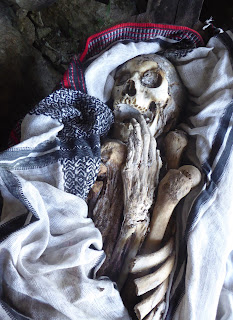Filipino mummies
A 30-day visa for a country made up of more than 7,000 islands … what to see and do in the time??
One thing I HAD to see (although it meant a different itinerary for two days for my friend and I) was the mummies of the Benguet region. I’d read online that their location is no longer publicised, since one of the mummies was stolen in 2017 (why??!), but was able to find out how to get to the Timbac mummy cave. This trip started with an early morning two-hour shared minivan to a small town in the mountainous interior. I was directed towards a group of local men, who asked where I wanted to go. As I referred to my hand-written notes on a scrap of paper (copied from a response to a facebook post), one of the men struggling to understand my pronunciation looked at the paper … and he saw the bracketed PHP500+, being the price I’d been advised to pay for a taxi from this town to the mummy cave at Timbac (some £7, for British readers). He couldn’t help but read that out loud, his voice rising an octave in excitement, as he repeated it to the other men with him.
So I suppose the person giving me that information had overpaid – but it was useful, as it meant I had the full attention of the group, as they muttered about guides, the keys to unlock the cave, etc. I was bundled into a car and we set off. A drive along small roads of some 20km, I think, but much of it uphill, and we reached a set of steps carved into the rocky hillside leading down to the cave. The driver accompanied me, and went off to find the guardian when we got there to find a metal grill across the cave entrance, locked shut. This guardian explained about the theft, but offered to accompany me to a different (un-signposted) nearby cave, where there were still mummies. So I followed him all the way back up those many steep steps, stopping for breath many times (I looked it up later and we were at 2,400m), and we continued along the road, down a short but unmarked and slippery trail, to arrive at a different cave. He unlocked the grill and opened a couple of the wooden coffins.
Wow!!!
Scientists believe these mummies were created by the Ibaloi tribe during the period 1200-1500. The dead body was washed and set over a fire in a seated position, thus drying the fluids. Tobacco smoke was blown into the mouth to dry the inside of the body and internal organs, then herbs were rubbed on the body. It’s estimated that the entire process could take weeks, sometimes months, to finish. They were then buried in the caves. The practice died out in the 1500s when the Spanish colonised the Philippines.The guardian saw that I was respectful towards the mummies, and he allowed me to gently touch them. But he noted that most of the skin had gone so that these were in part just skeletons, and he suggested that I might like to see the Apo Anno mummy, whose intact skin showed the amazing tattoos that covered these bodies. The driver agreed to take me (for extra money, of course) and we set out for about an hour’s drive along tiny roads (in places unsurfaced) through beautiful countryside, until he stopped outside a house in a small village. There lived a guide who knew the way through fields and up slippery tracks to another, hidden, cave, and his elderly uncle arrived by a different route with the key.
This one was even more impressive, a more-or-less intact mummy with beautiful tattoos all over the body. The story goes that a warrior hunter was guided by his dog to a waterfall (which was very close to the cave), where he encountered a beautiful long blonde-haired white lady taking a bath. The two got along, and she invited him to spend the night in her palatial cave. She instructed him to come back in nine months, then to take his son back to live with him, and that when he reached the prime of life the son should be mummified, given the best funeral treatment, and then the mummy buried in the cave where he was conceived. This was done, and the coffin miraculously floated up the small river, against the current, coming to rest at the river bank opposite the burial cave.





Comments
Post a Comment